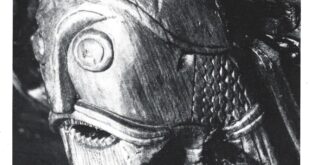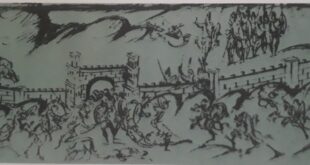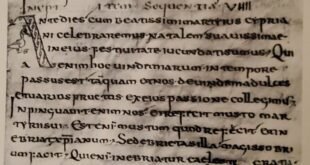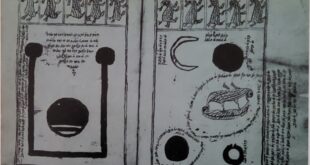T’ang Empire – first of the great Chinese dynasties – unifies the nation.
The siege of Byzantium
During the seventh and eighth centuries, while Europe was in the turmoil of the conflicting dynasties that had succeeded the first generations of barbarian invaders, events of immense importance were taking place on the southern shores of the Mediterranean.
Within a hundred years, the armies of Islam had taken the legendary city of Samarkand in the East, while in the West they touched for a moment the banks of the Loire. The successor of the Prophet Mohammed was not to sit on the throne of Constantine until another eight centuries had elapsed, but throughout the seventh and early eighth centuries, the threat to Byzantium was a serious one.
By 717 A.D., the Arab armies were actually at the gates of the imperial capital. Twice the siege was withstood; twice the Byzantine fleet proved its superiority and the armies of the new faith were driven back.
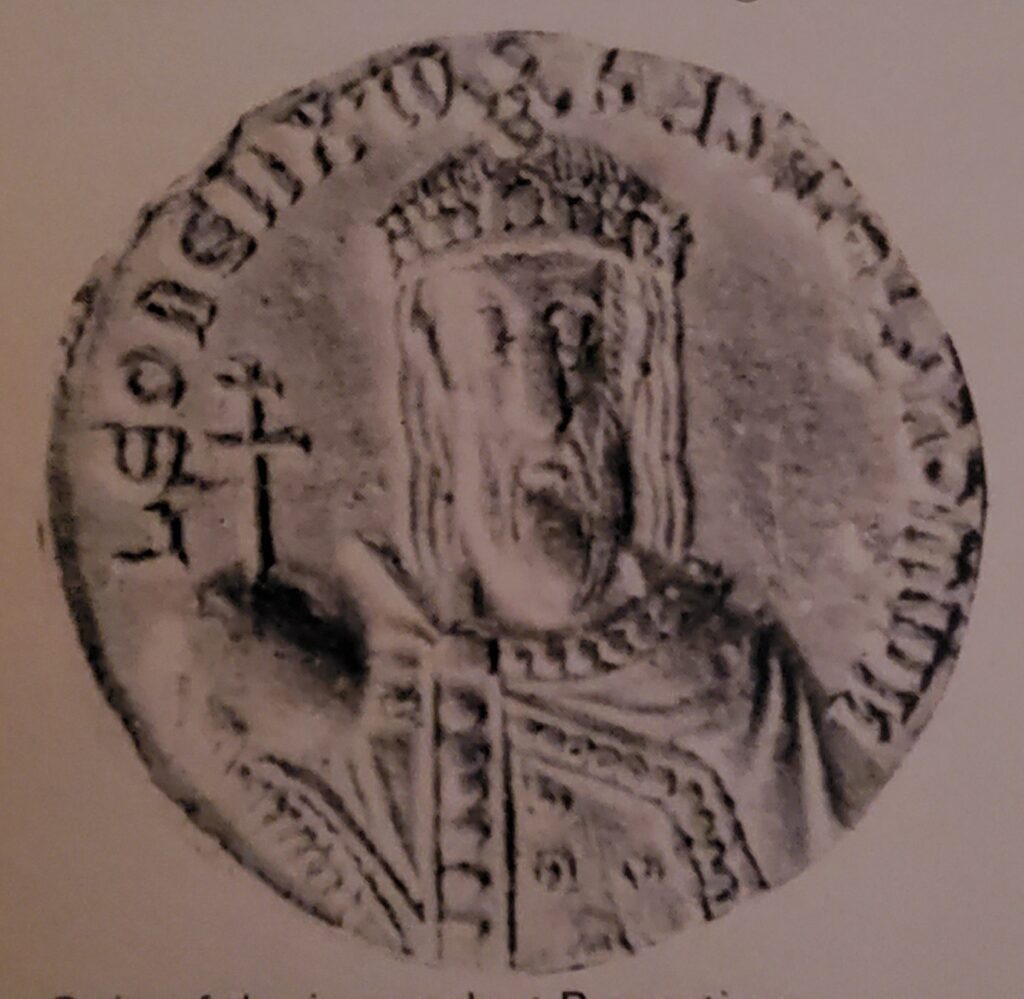
Although they escaped military conquest, the Byzantines did succumb to the influence of the religious philosophy of their enemies. Within ten years of the first siege of Constantinople, the Emperor Leo III, issued the first “iconoclastic” decrees against the worship of images. For close to a century, the Church in the East, prohibited images of the saints – the descendants of local deities that Christianity had displaced – and permitted only the barest decoration of its places of worship. The puritanic zeal of Islam infected its rival; and the Emperor Leo, determined to withstand the attack of the infidel, did not hesitate to emulate his virtues. For, like Christianity, the faith of Islam claimed universality; like Christianity, it was exclusive.
Islamic beliefs
Islam, however, differed from Christianity in two important respects. First, belief in a unitary God was absolute and uncompromising — to a Moslem, the Christian doctrine of the Trinity and the innumerable local cults of patron saints, inevitably appeared as a thinly veiled polytheism. In the second place, although Islam worshipped one god/Allah and believed that the full revelation had been given only to Mohammed, his Prophet, it nevertheless recognized parts of the Christian and Jewish canon that Mohammed himself had accepted. This fact reinforced the universal claims of Islam. It may have also been a factor in the welcome, that the conquering armies found among the subject populations of the Byzantine and Persian empires.
The faith of the conquerors was not entirely alien and still more important, they allowed their new subjects, to retain their own religious practice, only on condition of the payment of poll and land taxes. As we have seen in both the Roman and the Persian empires, religious heresy was often connected with political separatism; for many a provincial of the Near East, oppressed both by heavy taxation and religious discipline from the central government, the armies of Islam appeared as the scourge of God, for the sins of an irreligious emperor, or even as their liberator.

The birth of Arab civilization
After the first astonishing wave of Arab conquest had spent itself, the conquerors consolidated their position in their new empire by taking on many of the ways of the Persian monarchy, which they had displaced. Already by the time of the fourth Caliph, Uthman, the early ideals and puritan zeal were beginning to fade and the Caliph was using the semi-sacred office, to which he had been elected, to buttress his own position and that of his family. In 656 A.D., Uthman was assassinated and there followed a disputed succession that was to cause a schism in the faith of Islam, which has not healed to this day. Uthman was succeeded by Ali, who as son-in-law of Mohammed – had been expected by many to follow the prophet himself. In turn, Ali too was overthrown and the new Caliph, Muawiyah, who is generally regarded as the founder of the Ummayad dynasty, which held the Caliphate for the next hundred years. While the great body of Islam, the Sunnites, accepted the succession of the first four Caliphs and the laws and traditions (or sunni) of the early period, a minority of sectarians (shiites) hold that ever since the murder of Ali, the line of the Caliphate has been in the hands of usurpers.
The Dome of the Rock
Under the first Ummayads, the Arabs rapidly enlisted the services of the subject populations and assimilated their skills. Although few monuments survive from this period, they include such architectural achievements as the Dome of the Rock, in Jerusalem. This famous mosque is built over the spot, where according to Arab tradition, Abraham led Isaac to the sacrifice and where Mohammed ascended to heaven. Completed in 691 A.D., the Dome of the Rock was built on the orders of Abd al Malik, one of the greatest of the Ummayad Caliphs. He gave a new durability to the empire by introducing a standard coinage, reorganizing the government, improving communications within the empire and making Arabic its official language.
Although his own campaigns against Islam’s external enemies were inconclusive, Abd al Malik prepared the ground work for the resurgence of the eighth century.

The great Oriental civilizations
The art of the early Islamic potters gives the clearest possible evidence that Persian and Arab artisans were very strongly influenced by the high-glazed porcelain wares brought along the trade routes from T’ang China. The T’ang dynasty established in 618 A.D. just four years before the Hegira, reached the summit of its glory and power during the seventh century. The short-lived Sui dynasty had reformed the administration and radically improved communications, but the T’ang built on these foundations a brilliant and impressive edifice. T’ang armies extended Chinese power over the neighbouring territories of Korea, Manchuria, Mongolia, Tibet and Turkestan; the art of the potter was brought to the level of high art and T’ang scholars and poets produced an unequaled flowering in literature.

In the early decades of the dynasty, the influence of Indian Buddhism, which had been a part of Chinese religious life to greater or lesser degrees for centuries past, was powerful. It is from a Chinese Buddhist monk that one of the most interesting documents of the medieval world has come down to us. This is the Record of the Western World by Hsuang Tsang, who spent some twenty years researching in Indian Buddhist libraries during the first half of the seventh century. Although Buddhism retained an important position even under the later T’ang, it was to suffer periods of proscription and pride of place went to the social and ethical code of Confucius. The Confucian code, with its stress on the right ordering of social relationships, became the official religion of the empire, a role for which it was ideally suited.
The first century of T’ang China was not only a period of foreign expansion, but also one of ordered administration, in which centralized government was conducted by a class of officials recruited by a system of examination for merit — a system that was not to be emulated in the West until the nineteenth century. Like all great empires, of course, that of the T’ang was subject to the laws of decay. Already by the middle of the eighth century, the barbarian Uigurs had succeeded in wresting from the Empire, considerable tracts of territory on the borders, a situation that was seriously compounded by local rebelions during the ninth century.
Like his homeland of China, the India that Hsuang Tsang visited was enjoying a brief but glorious period of political unity and cultural advance. Under the rule of Harsha, who reigned from 606 to 647, virtually the whole of northern India was brought under the rule of a single government with its capital at the town of Kanauj. Harsha was himself a poet and philosopher. In early life he accepted the tenets of Hinduism, but was converted to Buddhism and became its devout and generous patron. The great Buddhist convocation held at Kanauj in 643, attended by some twenty kings and princes, not only symbolized the king’s devotion, but also his power. After the death of Harsha, India gradually split up again into a series of warring states.

The rise of Japan
We need hardly be surprised that these giant empires of the East, enjoyed such comparatively brief periods of unity. The areas that they attempted to control were immense; communications, unless constantly tended, fell rapidly into disorder and the frontiers were, under recurrent attack from barbarian invaders from central Asia. For the much smaller political units of Europe, the road to unity and stability was a long and difficult one. It is therefore all the more interesting, to find in the history of atleast one empire of this period that the ambitions of the central government were not beyond the possibilities of the situation and its abilities were commensurate with the problems. Although the mountainous geography of Japan encouraged internal divisions and although these divisions threatened the unity of the state from time to time, nevertheless, from the middle of the sixth century, Japan was to display considerable resilience and survival power as a political entity.

Invasion of Korea
As early as the fourth century, we have records of Japanese expeditions against the mainland kingdom of Korea. At that time, much influenced by the culture of China, Korea was to remain an important bridge for the transmission of Chinese influence to the island state. Even before the fourth century, this influence had been felt. The Japanese probably had knowledge of the Mandarin Chinese system of writing at a very early date and from the fourth century onwards, after what must have been a Herculean feat of adaptation (the two languages are in fact unrelated; Chinese is monosyllabic while Japanese is richly polysyllabic); the Japanese chancery was using a system of script derived from the Chinese system. The process of assimilating and adapting Chinese culture continued. Thousands of Chinese and Koreans came to settle in Japan, so that by the end of the seventh century a large number of the leading families of the Japanese aristocracy could boast of a mainland ancestry. From China too, in the fifth century, had come the religion of Buddhism. Although it never fully displaced the native Japanese cult system of Shinto, Buddhism quickly gained influential supporters, among them Crown Prince Shotoku Taishi (d. 621). Shotoku is remembered also as the creator of the first truly centralized Japanese administration, which took as its model that of China.
A recurrent feature of Japanese history is the ascendance of the powerful clans which, while recognizing the imperial house, sought to control the effective power of the state. Later, it became common for the emperor to turn over all but his ceremonial functions, to another member of the imperial family. This person in turn deputed effective executive authority to ministers of state.
The first important clan to win the ascendance in the state was that of the Soga; but in the middle of the seventh century they were displaced by the Fujiwara family, under the leadership of the great Fujiwara Kamatari. He consolidated and improved on the achievements of his predecessor, Prince Shotoku. Modeling his work almost slavishly on the example of the T’ang, he set up a centralized administration. In the early eighth century, a capital city was built at Nara, which was to emulate the splendours of Ch’ang ’an, the city of the T’ang emperors, but at the end of the century, the capital was moved to Kyoto, or Heian-Kyo as it was called, marking the beginning of a new age of elegance and courtly civilization.

